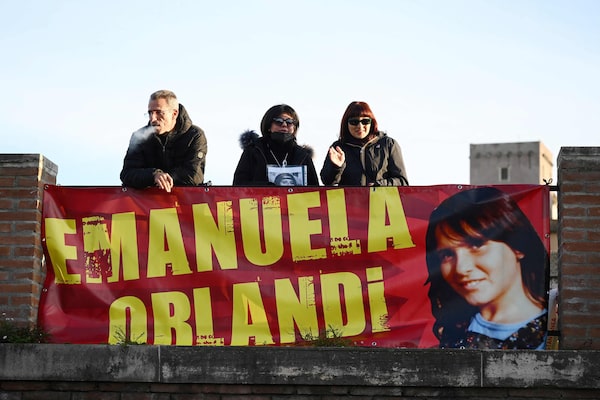
People hold a banner during a sit in, in the memory of Emanuela Orlandi, a teenager who disappeared in 1983 in one of Italy's darkest mysteries, behind St Peter's Square in the Vatican in Rome on Jan. 14.VINCENZO PINTO/AFP/Getty Images
Pope Francis has made transparency one of the main themes of his decade-long reign at the Vatican. He has demanded – and, to varying degrees, gained – greater openness when it comes to the Holy See’s financial affairs, its judiciary and sexual-abuse cases.
Last week, Francis upped the ante by reopening the cold case of the mysterious disappearance – and presumed murder – of Emanuela Orlandi, a Vatican citizen who vanished from the streets of Rome on June 22, 1983, never to be seen again by her family. Her body has not been found.
The case has gripped Italy for 40 years. It is considered one of the greatest mysteries in postwar Italian and Vatican history.
The timing of Francis’s announcement seemed to be no accident. It came 10 days after the death of his predecessor, Joseph Ratzinger, the former Pope Benedict XVI, who paid the case little attention, and three months after the release of the Netflix documentary Vatican Girl: The Disappearance of Emanuela Orlandi. The four-part series has renewed Italian and international interest in her story.
It also came shortly after Italian opposition lawmakers sought a parliamentary commission into three cold cases, including that of Emanuela. Senator Carlo Calenda, a former cabinet minister, demanded that the Vatican open all its files in the case, saying that the Holy See’s longstanding claim of total ignorance about her disappearance is “hardly credible.”
Alessandro Diddi, the Vatican’s new chief prosecutor, said that “all leads will be re-examined,” though he did not say that any new evidence had been found since the last Italian inquest into the disappearance closed in 2015, after nine years of work.
Mr. Diddi and the Vatican Gendarmerie will re-examine all the files, looking for new leads, fleshing out old ones and, presumably, examining the claim made by a childhood friend of Emanuela, revealed in the Netflix documentary, that she was the victim of sexual abuse inside the walls of the Vatican.
The news delighted Emanuela’s family, whose brother Pietro, along with the family’s lawyer, Laura Sagrò, have led the long campaign to revive the investigation into her disappearance. They have condemned the Holy See’s long “silence” on the case and now believe the answers lie inside the Vatican.
Emanuela was 15 when she vanished. Her father, Ercole, who died in 2004 (her mother, Maria, is 92), was a papal clerk, and the family lived in an apartment close to St. Peter’s Square. Emanuela had finished a flute lesson at a music academy near Rome’s Piazza Navona in the late afternoon and called home before she vanished, explaining that she had been approached by a man who offered her a job handing out flyers for Avon, the cosmetics firm. According to some accounts, she was last seen that day getting into a green BMW.
Her disappearance became an immediate sensation. Her image was plastered on posters throughout Rome, and Pope John Paul II used his regular Sunday address to the crowds in St. Peter’s Square to plead for her return. Some of Italy’s top investigative journalists jumped on the story.
As leads were chased down, the conspiracy theories set in.
One theory said she was kidnapped to put pressure on the Vatican to release Mehmet Ali Agca, the Turkish would-be assassin who shot and wounded John Paul in May, 1981, two years before Emanuela disappeared. Mr. Agca has accused the Soviet Union of sponsoring the attempted killing of the Polish Pope, perhaps because John Paul had supported Poland’s Solidarity movement and its fight to end communist rule in the country.
Another thesis, apparently also related to John Paul’s Polish campaign, said she was taken by the Mafia as a bargaining chip, because the Vatican had financed Solidarity with Mafia funds transferred from Italy’s Banco Ambrosiano to the Vatican Bank – or so this particular conspiracy theory went. Banco Ambrosiano was led by Roberto Calvi, known as “God’s banker” because of his close connections to the Vatican’s financial structure. His body was found hanging beneath London’s Blackfriars Bridge five days before Emanuela’s disappearance. Was the Mafia saying she would meet the same fate unless it was paid back?
One credible witness was a former prostitute and moll of Enrico “Renatino” De Pedis, leader of the Magliana Gang, a powerful, Mafia-like criminal organization that controlled big swaths of Rome. She claimed it was De Pedis who had Emanuela kidnapped and spirited away to a house just outside Rome, then taken to the Vatican, where she was driven away by a man dressed as a priest. Again, this episode was supposedly related to Mafia funds laundered through Banco Ambrosiano that the Mafia wanted back.
The Netflix series does break new ground in its interview with Emanuela’s childhood friend. Wearing a mask to disguise herself, she says Emanuela told her about a week before her disappearance that she had been molested by “someone close to the Pope.” Some high-profile Italian journalists, including Andrea Purgatori, believe the Magliana Gang found out about the abuse and used it to blackmail the Vatican.
Emanuela’s family has believed for many years that the Vatican has the power to solve this mystery, and may finally do so, thanks to Pope Francis’s intervention in the name of transparency. According to her brother Pietro, near the end of his life his father said: “I was betrayed by those I served.”
 Eric Reguly
Eric Reguly